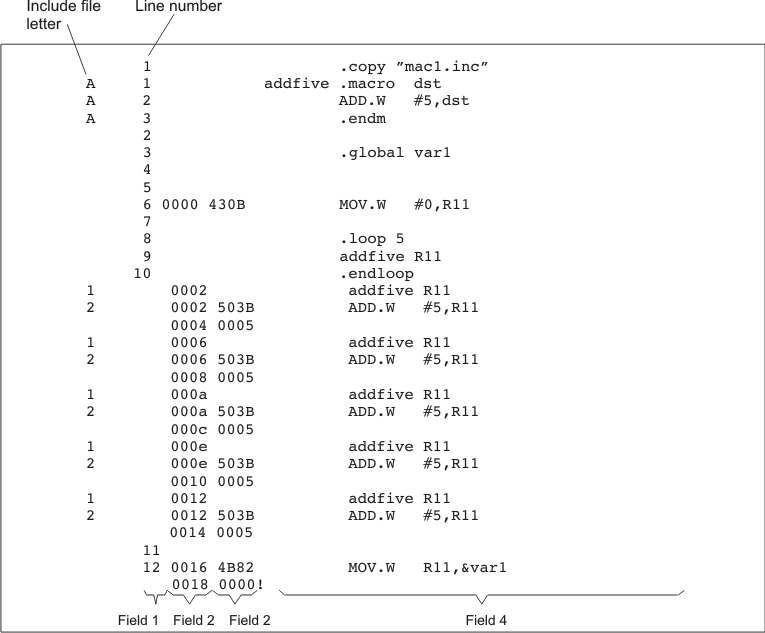SLAU131V October 2004 – February 2020
4.11 Source Listings
A source listing shows source statements and the object code they produce. To obtain a listing file, invoke the assembler with the --asm_listing option (see Section 4.3).
Two banner lines, a blank line, and a title line are at the top of each source listing page. Any title supplied by the .title directive is printed on the title line. A page number is printed to the right of the title. If you do not use the .title directive, the name of the source file is printed. The assembler inserts a blank line below the title line.
Each line in the source file produces at least one line in the listing file. This line shows a source statement number, an SPC value, the object code assembled, and the source statement. Figure 4-2 shows these in an actual listing file.
Field 1: Source Statement Number
Line number
The source statement number is a decimal number. The assembler numbers source lines as it encounters them in the source file; some statements increment the line counter but are not listed. (For example, .title statements and statements following a .nolist are not listed.) The difference between two consecutive source line numbers indicates the number of intervening statements in the source file that are not listed.
Include file letter
A letter preceding the line number indicates the line is assembled from the include file designated by the letter.
Nesting level number
A number preceding the line number indicates the nesting level of macro expansions or loop blocks.
Field 2: Section Program Counter
This field contains the SPC value, which is hexadecimal. All sections (.text, .data, .bss, and named sections) maintain separate SPCs. Some directives do not affect the SPC and leave this field blank.
Field 3: Object Code
This field contains the hexadecimal representation of the object code. All machine instructions and directives use this field to list object code. This field also indicates the relocation type associated with an operand for this line of source code. If more than one operand is relocatable, this column indicates the relocation type for the first operand. The characters that can appear in this column and their associated relocation types are listed below:
| ! | undefined external reference | |
| ' | .text relocatable | |
| + | .sect relocatable | |
| " | .data relocatable | |
| - | .bss, .usect relocatable | |
| % | relocation expression |
Field 4: Source Statement Field
This field contains the characters of the source statement as they were scanned by the assembler. The assembler accepts a maximum line length of 200 characters. Spacing in this field is determined by the spacing in the source statement.
Figure 4-2 shows an assembler listing with each of the four fields identified.
